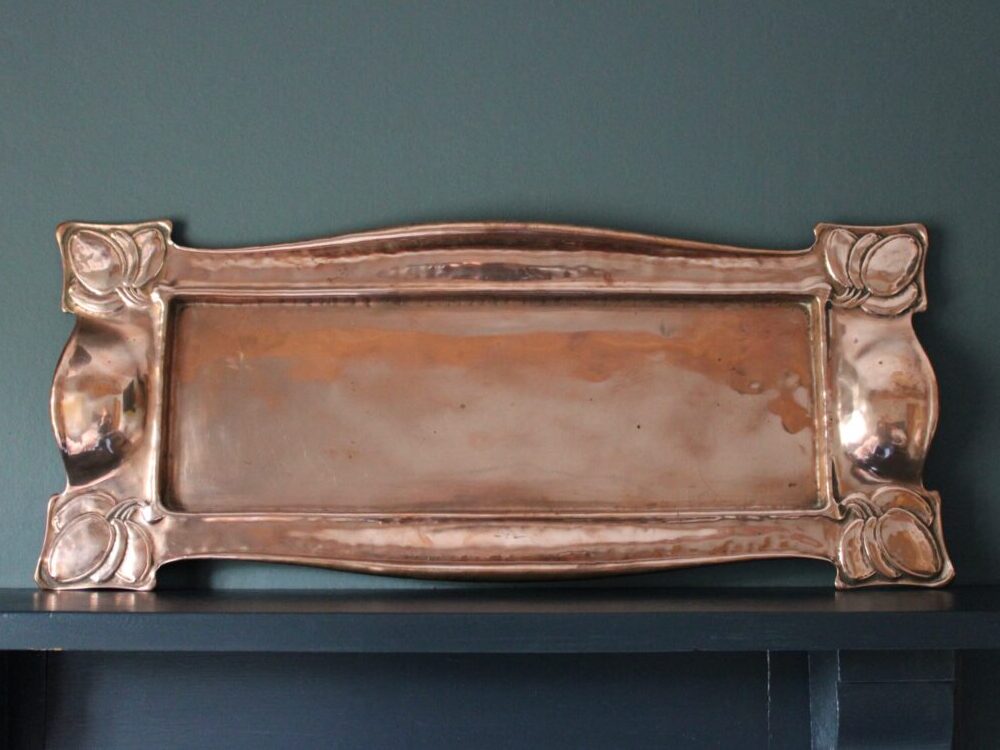Important Art Fittings Limited finds
The link between Norman and Ernest Spittle from Birmingham in England and Art Fittings Limited based in London is well established. Art Fittings Limited was the London showroom for the Spittle Brothers.
When Gustav Stickley visited England in 1903 he visited the Art Fittings Limited showroom and bought at least 17 items which he duly took back to the United States. Many of the designs he purchased were soon replicated, produced and sold by Gustav Stickley from his own workshops. I have spent a lot of time trying to figure out exactly which pieces Stickley purchased in 1903. Some are obvious as they went on to become iconic Stickley pieces but others are harder to determine as they weren’t produced in the Stickley workshops.
Two recent important finds illustrate this well. The first is a brass coal bucket.

Brass coal bucket by Art Fittings Limited, circa 1905
The design for this coal bucket originates from 1899 when a similar design was illustrated in The Studio (Vol.16, Page 52) by Norman and Ernest Spittle. At this time the priniciple designer for the firm was the talented Norman Spittle. The same design appears in later catalogues, circa 1905, from both Norman and Ernest Spittle and Art Fittings Limited.

Coal bucket by Norman & Ernest Spittle, The Studio, 1899 & both N & E Spittle and Art Fittings Ltd catalogues , circa 1905
After Gustav Stickley visited England at the start of 1903 he went back to the United States and held an Arts & Crafts exhibition in Syracuse and then Rochester, NY. At both exhibitions he featured the work he had bought from Art Fittings Limited. He also produced an article for his Craftman publication in May of 1903.
Four items made by Art Fittings Limited were illustrated, including the coal bucket. It’s interesting to note that the article states that the Art Fittings Company was from Birmingham in England.

Metal Work by Art Fittings of Birmingham, England. Featured in The Craftsman, May 1903
This coal bucket is a perfect example of how Stickley selected his favourite designs from a number of designers and makers in England before adopting them into his own range of metalwork. It’s hard to know whether the Spittle brothers ever sold the rights to these designs or possibly even encouraged their use to promote their own wares.

Coal bucket by Gustav Stickley (Model No: 350). Catalogue from 1905
Examples of Stickley produced coal bins are rare despite the fact that this model was produced by the Stickley workshops for many years.
An example sold by Sotheby’s: http://www.sothebys.com/en/auctions/ecatalogue/2009/important-20th-century-design-n08604/lot.229.html
The coal bin produced by Art Fittings Limited is a very rare example of one of the actual designs Stickley took to America, exhibited and then adopted.
The second recent find is a copper tray also made by Art Fittings Limited.

Copper tray made by Art Fittings Limited, circa 1905
It is one of the four pieces illustrated in The Craftsman article of May 1903 and also appears in the Stickley Arts and Crafts exhibition in The Rochester, NY. The tray can be seen mounted above the settle on the far wall.
The tray is similar in design to another tray produced by the Spittle brothers and marketed by Art Fittings Limited.

Copper tray made by Norman & Ernest Spittle, circa 1905
One tray went on to become a Stickley classic while the other was merely illustrated and exhibited in 1903. In a way this makes this second find a very rare example of one of the designs Stickley purchased during his visit in 1903.
Does anyone have the charger or the stick stand so that I can complete the set?